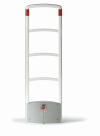Jan. 28, 2003 – Checkpoint Systems (NYSE: CKP), the second largest provider of electronic article surveillance (EAS) tags behind Tyco’s Sensormatic, has unveiled a new line of antennas called Liberty. The company says the new products are designed to bridge the gap between EAS and RFID.
“The EAS business as it relates to retail is very enamored with the concept of RFID,” says Dave Shoemaker, Checkpoint’s group VP for strategic marketing. “So we felt it was important to make a commitment several years ago to the development of RFID with the idea that retail will eventually use it.”
Retailers have shown tremendous interest in RFID because, when combined with smart shelf technology, it has the potential to alert staff to a potential theft while the customer is still inside the store (see Is This the Future of Retailing?). EAS, by contrast, only alerts staff when someone is leaving the store with a stolen item. By the time staff respond, it’s often too late.
Manufacturers complain about having to bear the cost of putting EAS tags on items when they are made. But the store gets most of the benefits. RFID potentially gives manufacturers some benefit because it can use it to track inventory in the supply chain.
Checkpoint, which is based in Thorofare, NJ, sells RFID library and access control systems. Now it wants to prepare for the day when retailers move from EAS to RFID. Shoemaker says that the new Liberty line of readers can be upgraded so that they not only alert staff when a shoplifter tries to leave with a tag that hasn’t been deactivated, but also reads data from the tag.
“In preparation, we’ve created an EAS platform that has built into its conception the ability to upgrade to be able to perform RFID in its footprint and design,” says Shoemaker. “When retailers start to get products in with RFID tags, they will be able to add the electronics that will enable them to use the RFID and ultimately connect to that for data.”
Shoemaker says the new line is “frequency agnostic,” which affords retailers “the largest framework of compatibility and risk-free investment in EAS that they could have asked for.”
The Liberty line includes the QX, PX, GX readers, which operate at 8.2 MHz, the most common frequency for EAS tags. Each includes two-way communications via Checkpoint’s new “CheckBase with CheckPro Reporter.” CheckBase is a stand-alone unit that initiates voice alarms, captures alarm activity from the system, and tracks alarm events at each antenna location.
CheckPro Reporter is software that supports automated alarm analysis and generates easy-to-read reports for detailed analysis of alarm events from multiple store locations using any computer on the retailer’s network, in-store or at a headquarters.
Shoemaker says the price for a system could range from less than $5,000 for a small retailer to $50,000 for a large retailer with many tag de-activation points.


